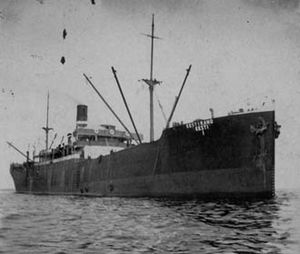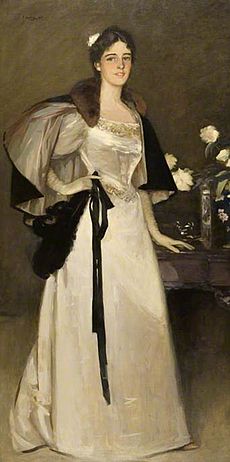William Burrell facts for kids
Quick facts for kids
Sir William Burrell
|
|
|---|---|
| Born | 9 July 1861 |
| Died | 29 March 1958 (aged 96) Hutton Castle, Scotland, United Kingdom
|
| Nationality | Scottish |
| Occupation | Ship owner |
| Known for | Art collecting |
Sir William Burrell (born July 9, 1861 – died March 29, 1958) was one of the world's most famous art collectors. He and his wife, Constance, Lady Burrell (1875–1961), gathered over 8,000 amazing artworks. They gave this huge collection to their home city of Glasgow, Scotland, in 1944. People have called it "one of the greatest gifts ever made to any city." Today, you can see these treasures at the Burrell Collection museum in Glasgow.
Contents
William Burrell's Life Story
William Burrell was born in Glasgow on July 9, 1861. He was the third of nine children. His father, William Burrell (1832–1885), owned ships. William's grandfather, George Burrell, started the family shipping company, which became Burrell & Son.
William grew up in a wealthy family of ship owners. He joined the family business in 1875 when he was just 14 years old. When his father passed away in 1885, William and his brother George took over. They were both in their twenties. They quickly made their company one of Britain's top cargo shipping businesses.
William was very good at business. He earned a large fortune. Most of his money came during World War I. He sold most of his ships for much more than he had paid for them.
His Passion for Art
William became interested in art when he was a boy. He used his wealth to build his collection steadily. Soon, he had more and better artworks than other collectors in his area. He became known around the world for his good taste and judgment.
Burrell had a natural talent for collecting art. He truly understood what he was buying. His refined taste led him to collect art that other people might have overlooked. He especially loved Gothic art. He built an amazing collection of medieval and Renaissance tapestries, stained glass, and furniture.
His collection of Chinese bronzes and ceramics is one of the best in the country. He also collected many French Impressionist masterpieces. These included works by Manet, Cézanne, and especially Degas. He supported Scottish artists like Joseph Crawhall II, George Henry, and John Lavery. In 1896, he asked Lavery to paint a portrait of his sister, Mary Burrell. This painting was shown widely and is considered one of Lavery's best works.
Giving Back to Society
Burrell used his wealth to improve his standing in society. He also bought Hutton Castle in Berwickshire. His Gothic art collection looked amazing there. But his wealth and art were not just for himself.
William Burrell cared deeply about public service. He served for a long time as a local councillor in Glasgow and Berwickshire. He was also a trustee for the National Galleries of Scotland and the Tate Gallery in London. He wanted his art collection to benefit everyone. He lent large parts of it to galleries across the country. This way, as many people as possible could enjoy it. In 1927, he was made a knight for his public work and his help with art in Scotland.
Unlike most collectors, he did not sell his collection or leave it to his family. In 1944, he gave most of his collection to Glasgow. At that time, it included 6,000 items. He kept adding to it, so today it has an amazing 9,000 artworks. He also gave smaller parts of his collection to Berwick-upon-Tweed and other local galleries. He wanted to boost the culture in these places.
The Gift to Glasgow
In 1944, Burrell gave his collection to the city of Glasgow. His gift was valued at over £1 million. He also gave an extra £450,000 in cash to build a special museum for it. This was a huge act of kindness. Burrell simply wanted people to enjoy art as much as he did. He hoped it would improve their lives by helping them understand and appreciate beauty.
Burrell had clear ideas about where the collection should be kept. He wanted it in a "suitable distinct and separated building." He also said it should be "within four miles of Killearn, Stirlingshire, and not less than sixteen miles from Glasgow Royal exchange." These rules were hard to meet. It wasn't until Glasgow bought Pollok Country Park in 1967 that a museum could be built as he wished.
A special museum, the Burrell Collection, finally opened in 1983. Some of his 17th-century Scottish furniture is also shown at Provand's Lordship in Glasgow.
His Family Life
In 1901, William Burrell married Constance Mary Lockhart Mitchell. They got married on September 19, 1901. William was 40, and Constance was 25. They were both from wealthy families. Constance was the daughter of a leading merchant and ship owner, James Lockhart Mitchell. She had inherited a lot of money.
Constance gave birth to their daughter, Marion, on August 6, 1902. The birth was not easy for Constance. She suffered a lot of physical pain. She also felt very down after Marion's birth. A few years later, Constance had an operation on her kidney. She had a long and difficult time recovering. Because of this, Constance had health challenges for the rest of her life.
Marion (1902–1992) grew up to be a well-known beauty in society. However, she had a difficult relationship with her parents. William would often step in to stop her romantic plans if he thought they were not suitable. She later changed her name to Silvia.
William shared his passion for collecting with his wife, Constance. She played an active role in building the collection. In his will, Burrell made sure to say: "I have had the benefit of my wife’s help in many ways including financial help and have received from her the greatest assistance and most wholehearted support in forming the collection . . . it is my desire that it be distinctly understood that the entire gift is from my wife and myself and that her name shall always be associated with mine and shall receive full acknowledgement in all official literature relating to the collection." William and Constance were loving partners throughout their lives. They worked together in their business, collecting, and charity efforts.
Later Years and Death
William Burrell passed away from heart failure caused by pneumonia. This happened at Hutton Castle on March 29, 1958. He was 96 years old. After years of declining health, Constance Burrell died from heart failure on August 15, 1961. She was 85 and also passed away at Hutton Castle. They are buried together in Largs, where many other family members rest.
Awards and Special Honours
William Burrell received several awards for his contributions:
- In 1927, he was made a Knight. This was for his public and political work, and for helping art in Scotland.
- In 1932, the Regent of Hungary honored him with the Hungarian Order of Merit, Second Class. This was for his "valuable services" in protecting Hungarian interests in Glasgow.
- On May 26, 1944, he was given the Freedom of the City of Glasgow. This is a very special honor.
- In 1946, he won the St Mungo Prize. This award goes to the person who has done the most to improve and promote Glasgow in the past three years.
Freemasonry
William Burrell was a Scottish Freemason. He joined the Prince's Lodge No.607. He became a member on May 9, 1892. He moved up in the group on November 7, 1892, and March 12, 1893. Being a Freemason was not a main part of his life.





